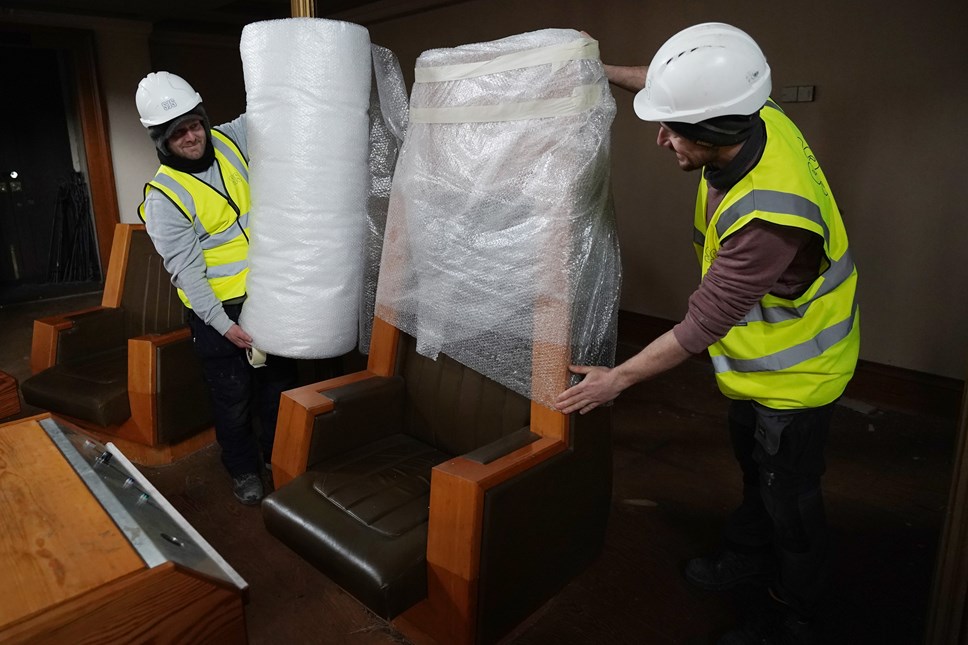
Speaker’s Chair from the Parliament building that never was acquired by National Museums Scotland
The Presiding Officer’s chair from what would have become the Scottish Parliament building in the event of a vote for devolution in the 1979 referendum has been gifted to National Museums Scotland.
It had been intended that the Scottish Assembly, as it was referred to at the time, would sit in the former Royal High School building on Calton Hill in central Edinburgh, and plans were sufficiently advanced for the Debating Chamber to have been furnished.
However, the referendum did not secure the required number of votes to achieve devolution. When the vote for devolution was later carried in 1997, the decision was taken to build a brand-new purpose-built Scottish Parliament building and so the chair was never used for its intended purpose.
Georgia Vullinghs, Assistant Curator of Modern and Contemporary History, said:
“We’re very pleased to be able to acquire this object. The furniture represents a key moment in the story of devolution and the history of Scottish politics. This large, blocky chair and its futuristic design is emblematic of a confidence in significant political change for Scotland in the late 1970s, but which did not ultimately happen at that time. This generous donation will allow us to better tell the story of that fascinating moment in Scotland’s history through our collections.”
The former Royal High School building is now undergoing a major restoration which will see it repurposed as a world-class centre for music education and public performance for the benefit of the whole of Scotland as the National Centre for Music. The Royal High School Preservation Trust (RHSPT) is leading the project and took possession of the building in March.
William Gray Muir, Chair of the RHSPT said:
“We are delighted that this piece of constitutional history will have a fitting home in the national museum, where it can help tell the story of how modern Scottish politics encountered the legacy of the Scottish Enlightenment. The significance of the Thomas Hamilton building – the Old Royal High – and its symbolic importance to our national political and social ambitions is indisputable and its past, present and future form a critical part of Edinburgh’s status in the world. The Trust’s aim is that we add a new chapter to that story and the building’s relationship with Scottish heritage and our national museum will continue.”
Although the Scottish Assembly never occupied the building, the site of the Royal High School remained a focal point in the debate over devolution, with images of the building
used in campaign material, and a Vigil for a Scottish Parliament was held outside the building for 1,980 days from 10 April 1992 until the 1997 referendum. The tent from the touring campaign and related material are on display in the National Museum of Scotland. The chair is now at the National Museums Collection Centre in Edinburgh where it will undergo conservation treatment.
Notes to editors
Notes to editors
1. About National Museums Scotland
National Museums Scotland is one of the leading museum groups in the UK and Europe and it looks after collections of national and international importance. The organisation provides loans, partnerships, research and training in Scotland and internationally. Our individual museums are the National Museum of Scotland, the National Museum of Flight, the National Museum of Rural Life and the National War Museum. The National Museums Collection Centre in Edinburgh houses conservation and research facilities as well as collections not currently on display.
· Twitter: @NtlMuseumsScot · Facebook: www.facebook.com/NationalMuseumsScotland
· Instagram: @NationalMuseumsScotland
2. Bheireadh Oifis nam Meadhanan eadar-theangachadh Gàidhlig den bhrath-naidheachd seachad do bhuidhinn mheadhanan bharantaichte. Cuiribh fios do dh'Oifis nam Meadhanan airson bruidhinn air cinn-latha freagarrach.
